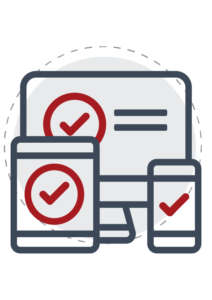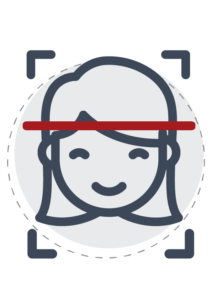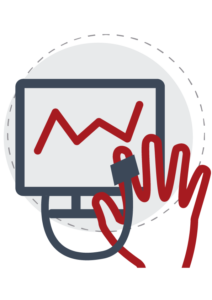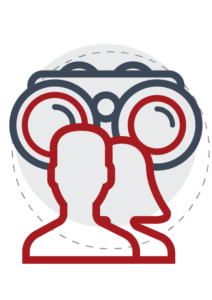Solutions
Qualitative Research
Know how the public and the market perceive your business
It is an exploratory research that identifies subjective and emotional aspects relevant to decision-making with regard to products, services, concepts, image, communication market, etc. It is a very information-rich approach, capable of identifying opinions, expectations and motivations in a deeper way, enabling knowledge, understanding and interpretation of certain behaviors of customers, non-customers, ex-customers, market and competition. It is a very conducive way to generate insights.
The most used techniques are:
Focus groups
In-depth interviews
Observation
Focus groups
 Meetings of invited participants, according to segmentation criteria and pre-set socioeconomic standards. The groups are guided by a specialized and experienced moderator, who stimulates the interaction and verbalization of their opinions and emotions from the participants. Such meetings also make it possible to apprehend the references of these people, at less rational levels, when allowing visions of the world and the studied theme to emerge, without a strict limitation of pre-established categories, in an informal and pleasant environment.
Meetings of invited participants, according to segmentation criteria and pre-set socioeconomic standards. The groups are guided by a specialized and experienced moderator, who stimulates the interaction and verbalization of their opinions and emotions from the participants. Such meetings also make it possible to apprehend the references of these people, at less rational levels, when allowing visions of the world and the studied theme to emerge, without a strict limitation of pre-established categories, in an informal and pleasant environment.In-depth interviews
 These are individual, personal or telephone interviews, unstructured, conducted by a qualified interviewer who is familiar with the subject, which naturally stimulates and ‘provokes’ the participant to reveal personal motivations, beliefs, attitudes and feelings about certain topics previously agreed on in an interview. script. Respondents are encouraged to speak freely about the topics, spontaneously venting different emotions or perceptions that are hardly noticeable in other techniques.
These are individual, personal or telephone interviews, unstructured, conducted by a qualified interviewer who is familiar with the subject, which naturally stimulates and ‘provokes’ the participant to reveal personal motivations, beliefs, attitudes and feelings about certain topics previously agreed on in an interview. script. Respondents are encouraged to speak freely about the topics, spontaneously venting different emotions or perceptions that are hardly noticeable in other techniques.Observation
 These are observations of the behavior of participants in certain environments or in specific situations of purchase, interaction with the brand, in the provision of services, relationship with employees, among others. Such observations are made by trained and experienced professionals, based on a semi-structured script that previously specifies the most important aspects, without inhibiting the eventual monitoring of unforeseen or unknown situations. They can be ethnographic or hidden client research.
These are observations of the behavior of participants in certain environments or in specific situations of purchase, interaction with the brand, in the provision of services, relationship with employees, among others. Such observations are made by trained and experienced professionals, based on a semi-structured script that previously specifies the most important aspects, without inhibiting the eventual monitoring of unforeseen or unknown situations. They can be ethnographic or hidden client research.Quantitative Research
Clear and reliable data for an objective view of the business in decision making
Quantitative research enables decision making with a greater degree of certainty, as it guides itself through representative samples of the universe to be considered and covers the relevant segments for each analysis. The data collection usually takes place through structured questionnaires with objective (closed) questions and also with open questions that allow the free expression of the interviewees.
The most used resources are:
CATI
CAPI / Face to face
Web / Panel
URA
CATI
 These are telephone interviews, all duly recorded and monitored by a team of Checon supervisors, both to ensure higher quality and for eventual audits by the final customers or the certifying entity. The interviewers are previously trained and qualified in the questionnaire, and at Checon, this activity is only carried out by interviewers with completed or ongoing higher education.
These are telephone interviews, all duly recorded and monitored by a team of Checon supervisors, both to ensure higher quality and for eventual audits by the final customers or the certifying entity. The interviewers are previously trained and qualified in the questionnaire, and at Checon, this activity is only carried out by interviewers with completed or ongoing higher education.CAPI / Face to face
 These are personal interviews applied by tablet, all of which are recorded and monitored by a team of Checon supervisors, both to ensure higher quality and for eventual audits of the final customer or the certifying entity. The interviewers are previously trained and qualified in the questionnaire, and at Checon, this activity is only carried out by interviewers with completed or ongoing higher education.
These are personal interviews applied by tablet, all of which are recorded and monitored by a team of Checon supervisors, both to ensure higher quality and for eventual audits of the final customer or the certifying entity. The interviewers are previously trained and qualified in the questionnaire, and at Checon, this activity is only carried out by interviewers with completed or ongoing higher education.Web / Panel
 These are interviews applied via the web, with countless resources, such as the possibility of filling out the questionnaire to be carried out at different times by the participant, enabling the monitoring of partial results as soon as each interview is completed, allowing faster and more economical access to geographically dispersed audiences, greater control of the sample, viewing of films and images, etc.
These are interviews applied via the web, with countless resources, such as the possibility of filling out the questionnaire to be carried out at different times by the participant, enabling the monitoring of partial results as soon as each interview is completed, allowing faster and more economical access to geographically dispersed audiences, greater control of the sample, viewing of films and images, etc.URA
Neuromarketing
The union of marketing with science
Find answers far beyond the questionnaire. Neuromarketing makes it possible to know and evaluate the emotional and spontaneous reactions when a person is exposed to advertisements, brands, products, websites, advertisements, among other stimuli. The technique goes beyond ‘conventional’ research, where only questions are answered and complements the analytical approach with the instinctive and the emotional, based on technical and scientific measurements. Consumer reactions can be perceived by means of equipment that measure heartbeat, monitor eye movement, identify facial expressions, capture electrical currents from the skin, among other body reactions that in conventional methodologies are not noticeable, although they almost always influence significant way in decision making.
At Checon, different biometric measurement techniques are used and these resources have been permanently incorporated into the scope of our supply, as technological developments are consolidating.
At Checon, different biometric measurement techniques are used and these resources have been permanently incorporated into the scope of our supply, as technological developments are consolidating.
Among the most used, the following are worth mentioning:
Eye Tracking
Analysis of facial expressions
Skin Conduction
Implicit testing
Eye Tracking
 Checon’s eye tracking technology allows identification of 120 times per second where the eyes stop and where they ‘navigate’, in addition to enabling the determination of the level of attention, focus, awareness and other mental states, with metrics and information that is used to generate insights into consumer behavior, user experience (UX), communication effectiveness, to design revolutionary interfaces on multiple devices, among other applications.
Checon’s eye tracking technology allows identification of 120 times per second where the eyes stop and where they ‘navigate’, in addition to enabling the determination of the level of attention, focus, awareness and other mental states, with metrics and information that is used to generate insights into consumer behavior, user experience (UX), communication effectiveness, to design revolutionary interfaces on multiple devices, among other applications.Analysis of facial expressions
 It is a software that, from the participants’ facial expressions, identifies the different emotions (surprise, anger, joy, sadness, disgust, happiness, fear) and the respective valence (if negative, positive and neutral). The metric is based on the measurement of facial muscle dislocations such as eyebrow dislocation, the movement of the corner of the lips, the closing of the eyes, the pressing of the lips, among others. The entire set of data allows an interpretation of people’s reactions to stimuli, based on micro expressions that would almost always go unnoticed or are not even recognized by the participants themselves.
It is a software that, from the participants’ facial expressions, identifies the different emotions (surprise, anger, joy, sadness, disgust, happiness, fear) and the respective valence (if negative, positive and neutral). The metric is based on the measurement of facial muscle dislocations such as eyebrow dislocation, the movement of the corner of the lips, the closing of the eyes, the pressing of the lips, among others. The entire set of data allows an interpretation of people’s reactions to stimuli, based on micro expressions that would almost always go unnoticed or are not even recognized by the participants themselves.Skin Conduction
 It is a software that makes it possible to measure the level of people’s emotional arousal from stimuli (visual or acoustic), as well as to identify stress and spontaneous reactions, based on the changes detected in the conductivity of people’s skin, identifying current variations based on biometric measurements referenced by each participant.
It is a software that makes it possible to measure the level of people’s emotional arousal from stimuli (visual or acoustic), as well as to identify stress and spontaneous reactions, based on the changes detected in the conductivity of people’s skin, identifying current variations based on biometric measurements referenced by each participant.Implicit testing
 It is a software that allows to detect, in an almost playful way, the strength of the automatic association that a person makes between the mental representations of objects (concepts), brands, products, services, companies, from their own memory and their personal values. It is a very relevant measure to measure attitudes and preferences that can hardly be verbalized, because, in most cases, we are not even aware of them.
It is a software that allows to detect, in an almost playful way, the strength of the automatic association that a person makes between the mental representations of objects (concepts), brands, products, services, companies, from their own memory and their personal values. It is a very relevant measure to measure attitudes and preferences that can hardly be verbalized, because, in most cases, we are not even aware of them.Usability (UX)
Understand how your customer uses your company’s platforms
Usability testing is a technique used to evaluate the experience of a customer, consumer, prospect or just a user. Each participant is asked to perform typical tasks while their behavior is monitored by a data collection instrument and a moderator. It is important to note that Checon has been using EyeTracking since 2009 as an aid tool in usability testing in evaluations of portals, websites, screens for self-service machines, etc. Information such as’ 1a. fixation area ‘,’ fixation time ‘,’ number of visits’, ‘the way the screen is covered’, ‘perception and influence of banners’, among other numerous metrics. As with other types of research, it is important to properly select users who are representative of the public during the preparation of the study. Many usability tests focus on what people do, however, at Checon we also delve into what they say during (or after) navigation, to enrich the study with qualitative technique.
Secondary Data
Insights for your business with information already available in the market
Comprise surveys of market data, research documents available
Bibliographic Surveys
Documentary Surveys
Statistical Surveys
Survey of Research Conducted
Bibliographic Surveys
 The bibliographic survey consists of looking for public information relevant to research in books, magazines, newspapers, dissertations, theses, both from government agencies, as well as from other sources such as private entities, employers’ or labor unions, class associations, non-governmental organizations. among others.
The bibliographic survey consists of looking for public information relevant to research in books, magazines, newspapers, dissertations, theses, both from government agencies, as well as from other sources such as private entities, employers’ or labor unions, class associations, non-governmental organizations. among others.Documentary Surveys
 The survey consists of the analysis of documents of interest to the research, such as information that is available inside or outside the company itself, for example: number of customers per segment, number of products sold, number of employees involved in each project, data on production, inventory volume, monthly sales, advertising campaign expenses, estimated ROI’s, time spent on tasks and etc. Depending on the project, such information may be essential to have a general idea of the business and make a more assertive analysis.
The survey consists of the analysis of documents of interest to the research, such as information that is available inside or outside the company itself, for example: number of customers per segment, number of products sold, number of employees involved in each project, data on production, inventory volume, monthly sales, advertising campaign expenses, estimated ROI’s, time spent on tasks and etc. Depending on the project, such information may be essential to have a general idea of the business and make a more assertive analysis.Statistical Surveys
 It consists of the analysis of statistics and historical series generated by public or private sector companies, such as IBGE, FGV, IPEA, FIESP, CNI, etc.
It consists of the analysis of statistics and historical series generated by public or private sector companies, such as IBGE, FGV, IPEA, FIESP, CNI, etc.Survey of Research Conducted
 It is extremely valid that, before any other effort or investment, a certain amount of time is spent to ascertain whether research that has already been carried out by the company, addressing the theme that is to be studied, does not have relevant information to be considered, even if only as series historical. Based on previous surveys, the preparation of the new research can be much more assertive, focusing on the points that must be raised. Previous research may also have been applied with different methodologies than the one intended at the moment, thus giving another perspective on how the study may be set up.
It is extremely valid that, before any other effort or investment, a certain amount of time is spent to ascertain whether research that has already been carried out by the company, addressing the theme that is to be studied, does not have relevant information to be considered, even if only as series historical. Based on previous surveys, the preparation of the new research can be much more assertive, focusing on the points that must be raised. Previous research may also have been applied with different methodologies than the one intended at the moment, thus giving another perspective on how the study may be set up.Business Intelligence
All your data in one panel, with all possible combinations
Dashboards (panels) customized for monitoring indicators in your company
Monitoring of indicators
Monitoring social networks
Monitoring of indicators
 Performance indicators are measurable values that demonstrate how effectively a company is achieving its main business objectives. Selecting the right indicators will depend on what part of the business your company wants to monitor and we are here to help. We develop panels customized for the specific needs of your business, where the historical series and the combinations of filters allow a greater understanding of the current situation and the identification of strengths and weaknesses. The graphic visualization of such results is a relevant tool for identifying solutions and generating insights.
Performance indicators are measurable values that demonstrate how effectively a company is achieving its main business objectives. Selecting the right indicators will depend on what part of the business your company wants to monitor and we are here to help. We develop panels customized for the specific needs of your business, where the historical series and the combinations of filters allow a greater understanding of the current situation and the identification of strengths and weaknesses. The graphic visualization of such results is a relevant tool for identifying solutions and generating insights.Monitoring social networks
 Customized panels, capable of generating periodic reports through the monitoring of keywords, whether mentioning the brand name, product names or hashtags. All of this in an automated and uninterrupted way. Feed your strategic plan with data extracted continuously and automatically from social networks. The information generates the possibility that the company is always ready to act and improve its reputation with the public. Follow what is being said about your brand and take action based on those insights.
Customized panels, capable of generating periodic reports through the monitoring of keywords, whether mentioning the brand name, product names or hashtags. All of this in an automated and uninterrupted way. Feed your strategic plan with data extracted continuously and automatically from social networks. The information generates the possibility that the company is always ready to act and improve its reputation with the public. Follow what is being said about your brand and take action based on those insights.